CAPACITY 50,000 lbs at 48” load center - moving over rough terrain
CAN STACK ISO CONTAINERS TWO HIGH
LENGTH W/ FORKS 420”
WIDTH 138”
HEIGHT 167”
WEIGHT W/OUT
TOP HANDLER 103,000 lbs TOP HANDLER WEIGHTS: 20’ 3,888 lbs
40’ 9,927 lbs
FORDING 60” Sea Water Figure B-1
B-3.
INTERMODAL CONTAINER-HANDLING SPREADER BARS. Spreader bars (see Figure B-2) are connected by slings to the hook of a crane such as a RTCC or the 140-ton truck-mounted container-handling crane and are used to handle ANSI/ISO and other intermodal containers.
The Army has two types of spreader bars; one for handling 20-foot long containers and the other for handling 40-foot long containers. The 40-foot spreader bars can also handle many longer containers since they usually have ANSI/ISO corner fittings at 40-foot spacing. Both spreader bar types conform to Military Specification MIL-S-52713 and are fixed frame designs with manually locking twist locks.
B-2
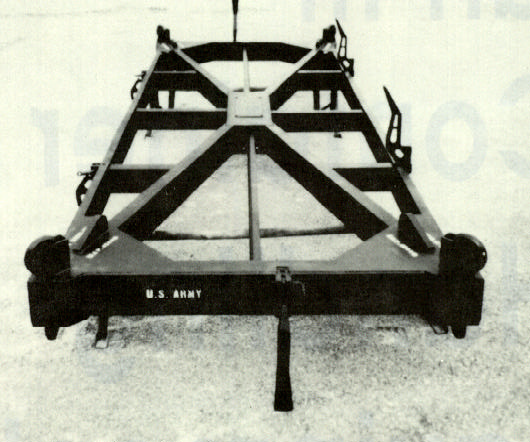
FM 55-80
INTERMODAL CONTAINER-HANDLING
SPREADER BARS
20-FOOT 40-FOOT
CAPACITY 44,888 lbs 67,200 lbs
LENGTH 19’10” 40’
WIDTH 7’11” 7’11”
HEIGHT 1’6” 1’6”
WEIGHT 3,000 lbs 5,000 lbs
Figure B-2
B-4.
ROUGH TERRAIN CONTAINER CRANE. The RTCC (see Figure B-3, page B-4) is a wheel-mounted crane available through commercial sources. The RTCC is capable of lifting a 20-foot container weighing 44,800 pounds at a radius of 27 feet and a 35/40-foot container weighing 67,200 pounds at a radius of 22 feet. It can be operated on hard surfaces or on soft surfaces when using wooden platform sections to carry the weight. GS ammunition units, located in theater and corps ammunition storage areas, use the RTCC to load or transship 20-foot ANSI/ISO containers from one mode of transportation to another. Transportation units use the RTCC to augment the 50,000-pound rough terrain container handler in the transfer and handling of 20-, 35-, or 40-foot containers and other cargo between transportation modes and in storage areas.
B-5.
140-TON, TRUCK-MOUNTED CONTAINER-HANDLING CRANE. The 140-ton crane (see Figure B-4, page B-4) is a commercially designed crane used by the Army. It is truck-mounted, and has 140-ton maximum capacity at a reach of 12 feet. It has an 8- by 4-foot truck chassis and a 50-foot basic boom which can be extended in length up to 130 feet with the use of various lengths of lattice boom. The crane is used for loading and unloading containers from ships in a fixed port operation or watercraft/lighterage in a LOTS operation and for handling containers in B-3
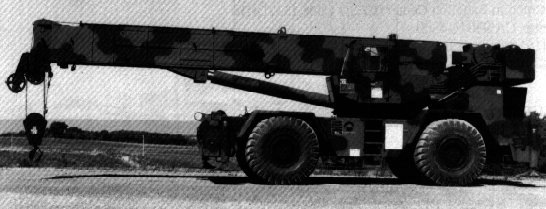
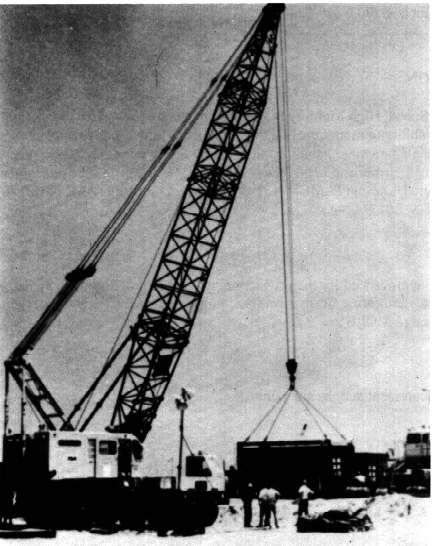
FM 55-80
marshaling areas and terminal sites. In a LOTS operation, the 140-ton crane may be used to lift cargoes of all types from the ocean-going ship to the lighterage/watercraft or on the beach to transfer these cargoes from lighterage to the beachhead. The 140-ton crane may be placed on an elevated causeway of a floating causeway to discharge cargoes from the watercraft. On the beach, wooden platform sections are used to prevent the crane from sinking into the sand. The crane must be partially disassembled for transport.
40-TON ROUGH TERRAIN CONTAINER CRANE (RTCC)
The 40-ton RTCC is designed to support 20- and 40-foot container intermodal operations. It is authorized in Ordnance and Transportation units.
CAPACITY 44,800 lbs at 27 foot radius 67,200 lbs at 22 foot radius
80,000 lbs at 10 foot radius
TRANSPORTABLE BY RAIL, HIGHWAY, MARINE (NOT AIR) ROAD SPEED 18 MPH
CROSS COUNTRY MOBILITY
LENGTH 548”
WIDTH 145”
HEIGHT 153”
WEIGHT 95,260 lbs
Figure B-3
140-TON TRUCK-MOUNTED CONTAINER-HANDLING CRANE
CAPACITY 140 tons
APPROXIMATELY 12’
LENGTH W/ 50’ BOOM 873”
WIDTH 132.5”
HEIGHT 157.8”
WEIGHT W/ 120’ BOOM 195,000 lbs
B-4
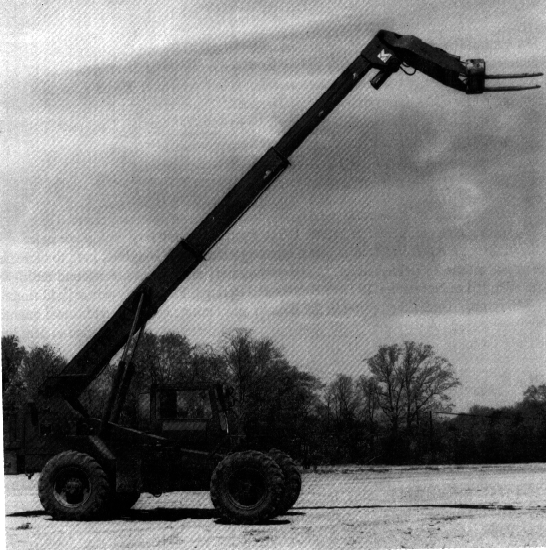
FM 55-80
Figure B-4
B-6.
4,000-POUND ROUGH TERRAIN FORKLIFT. The 4K RTF is designed to stuff or unstuff cargo transported in 20- or 40-foot ANSI/ISO containers. It is found in Quartermaster, Transportation, Ordnance, Missile & Munitions, Medical, Aviation, and Engineer units. It is easily deployable in a 20-foot container.
B-7.
6,000-POUND VARIABLE REACH FORKLIFT. This forklift (see Figure B-5) is typically found in the COMMZ, corps, division, and brigade rear area ammunition storage areas. It has advantages over the 4K RTF in that it can load and unload cargo from trucks without the assistance of a ramp. When outfitted with special tool attachments it can extract MLRS pods from containers.
6K VARIABLE REACH FORKLIFT
The 6K variable reach, rough terrain forklift is designed to load and unload palletized ammunition and MLRS pods from 20-foot containers.
CAPACITY 6K lift w/ boom extended 15 ft 4K lift w/ boom extended 21 ft
FORDING 24 inches
ROAD SPEED 23 MPH
CROSS COUNTRY MOBILITY
C-130 TRANSPORTABLE
Figure B-5
B-8.
ALL-TERRAIN LIFTER, ARMY SYSTEM. This is the newest MHE/CHE entering the Army system (see Figure B-6, page B-6). Fielding should begin in late FY 97. This is a 10,000-pound variable reach, air transportable, rough terrain forklift. The ATLAS will be found in Aviation, Engineer, Medical, Ordnance, Transportation, and Quartermaster units. It can stuff and unstuff 20-foot containers.
B-5
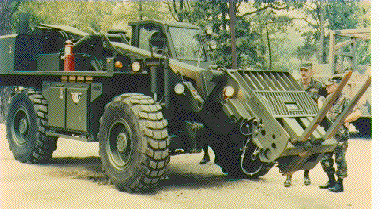
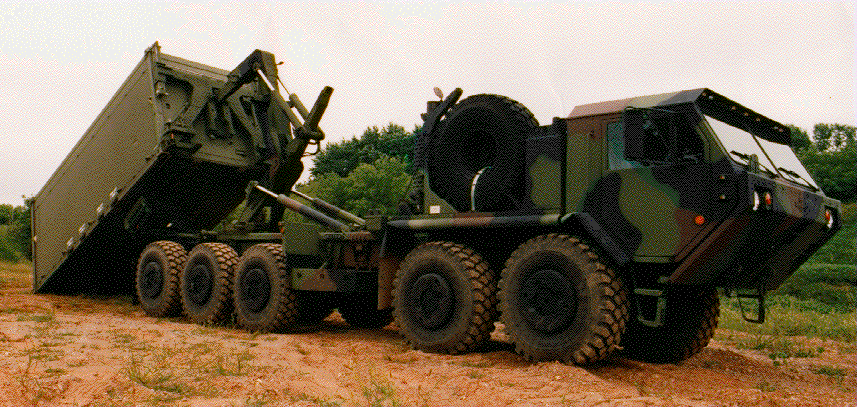
FM 55-80
B-9.
LOAD HANDLING SYSTEM CONTAINER HANDLING UNIT. The CHU attaches to the load handling system on the PLS. It allows the PLS to self load 20-foot containers without requiring the container to be loaded on a flatrack. The PLS truck can carry the CHU aboard the vehicle in addition to the standard flatrack hook. The PLS with a CHU is capable of lifting 20-foot ANSI/ISO containers weighing up to 36,250 pounds. Figure B-7 shows a PLS lifting a 20-foot container with a CHU attached to the lifting arm.
ALL TERRAIN LIFTER ARTICULATED SYSTEM (ATLAS)
The ATLAS is a variable reach, C-130 air transportable, rough terrain forklift.
CAPACITY
10,000 lbs at 48” center of balance
VARIABLE REACH 21 feet
ROAD SPEED 23 MPH
FORDING 36 inches
CROSS COUNTRY MOBILITY
Figure B-6
CONTAINER HANDLING UNIT
(CHU)
CHU
A PLS vehicle configured to use the CHU has swivel rollers installed on the bed of the truck to allow the container to roll-on during the lifting process. The CHU lifts a 20-foot container without a flatrack.
B-6
FM 55-80
Figure B-7
B-10.
20/40-FOOT CONTAINER SIDELOADER. The diesel-powered container sideloader is a commercial item capable of transferring or self-loading and transporting 20- through 40-foot ANSI/ISO containers. Typically, the maximum lifting capability is 66,150 pounds. Units are available with a telescoping spreader bar for 20-, 35-, and 40-foot length containers and can also lift containers with slings. The sideloader can transport containers within maximum road height limitations. It also has an air ride suspension enabling it to transport ANSI/ISO containers containing delicate equipment. These are primarily found at commercial facilities and at Depots.
The advantage sideloaders offer over RTCHs are the reduced amount of maneuver space required.
Rough terrain container sideloaders are offered through commercial sources.
B-7
FM 55-80
APPENDIX C
SAMPLE THEATER SOP
This is an example of a SOP used in Korea. It will give you an idea of the necessary instructions needed at the various MCA offices engaged in container coordination. This is only a guide as every theater will have unique requirements.
APPROPRIATE UNIT ID
ATTN: OFFICE SYMBOL
ADDRESS
DATE
ABC UNIT (TMD/CONTAINER CONTROL ACTIVITY) SOP NO X-X
TITLE: Container Operations in Korea
1. PURPOSE: To establish standard policy and procedures for the offering, scheduling, and monitoring of the inland surface movement of all SEAVANs destined for US/UN Forces in Korea, including NAF Activities 4.
2. SCOPE: This SOP is applicable to the Container Control Activity Pusan under the Traffic Management Division of ABC Medium Port Command, Pusan.
3. DEFINITIONS:
a. CBL - Commercial Bill of Lading.
b B.B.P. - Breakbulk Point.
c. DSSK- Direct Support System - Korea.
d. DTL - Discharge Tally List.
e. GBL - Government Bill of Lading.
f. AAFES - Army Air Force Exchange Service.
g. NAF - Non-appropriated Fund Activity.
h. NLT - Not Later Than.
i. POD - Port of Debarkation.
j. POE - Port of Embarkation.
C-1
FM 55-80
k. RG - Rate Guide (long title: MSC Container Agreement and Rate Guide).
l. SEAVAN - Containers owned and/or controlled by a commercial shipping company.
(The terms SEAVAN and CONTAINER have the same meaning.)
m. TCMD - Transportation Control and Movement Document.
n. MCT - Movement Control Team.
o. CY - Container Yard.
4. REFERENCES: The MSC Container Agreement and Rate Guide, Bailment Agreements, and applicable instructions directives relating thereto.
5. OBJECTIVE: To outline and provide guidance for monitoring and ensuring the proper control of SEAVANs moving through the ports in Korea.
6. RESPONSIBILITIES:
a. Chief, Traffic Management Division is responsible for the supervision of the 1317th Medium Port Command. The senior HN in CCA is responsible for ensuring the smooth functioning of CCA on a daily basis.
b. Container Control Authority (CCA).
(1) Maintain close supervisory control over the container control function in the ports of Korea. Responsible for the scheduling, monitoring, and overall control of all import SEAVANs offered to the TMCA for inland/drayage/line haul in Korea.
(2) Monitor all container shipments which exceed the allowed free time, as defined in the current RGs and Bailment Agreements. Identify and assist the TMCA in resolving container backlog problems, off-loading and scheduling of containers by consignees, and ensuring empty containers are returned to the ocean carriers CYs.
(3) Assist consignees and the TMCA MCTs, RMCTs in tracking containers that are en route to consignees and have failed to arrive, or which are delayed by the consignee.
(4) Upon receipt of Cargo Traffic Messages and Army manifest for SEAVAN
container, CCA Pusan, will screen changes of POD, terms or consignee(s). Changes will be coordinated by message to the POE for corrected documentation.
(5) Monitors all container shipments which exceed the authorized free time as defined in the current RG and Bailment Agreement. Identify and assist TMOs of the TMCA and consignees in resolving container backlog problems, offloading and scheduling of containers by consignees, and returning empty containers to ocean carrier’s CYs.
C-2
FM 55-80
7. PROCEDURES:
a. General.
(1) The CCA Pusan will be responsible for maintaining records of control for all containers consigned to Eighth US Army, US Forces Korea, and UN Forces within Korea, including those consigned to AAFES and NAF activities. Initial record control will commence upon receipt of the Cargo Traffic Messages and advanced Army cargo manifests for import SEAVAN cargo.
Actual control will commence when the ocean carrier’s agent has made containers available to the CCA.
(2) Determine appropriate inland destination service to be provided from ocean carrier’s CY to consignee based upon the following delivery terms: (a) K term: A container dread or line hauled by government-owned or contractor’s tractor from carrier’s CY or port terminal to the consignee.
(b) L term: A container dread by ocean carrier or his agent from the carrier’s CY or port terminal to a consignee located within a 10-mile radius of that port city limits (local area delivery).
(c) M term: A container line hauled by ocean carrier or his agent from carrier’s CY or port terminal to a consignee located outside the 10-mile radius of that port city limits.
(3) Upon receipt of Cargo Traffic Messages and Army cargo manifests for the SEAVAN, the container control function will establish and ocean manifest file for each vessel as documentation is received. This file will remain active until all containers have been unstuffed and returned to the ocean carrier or his agent.
(4) DSSK (by TK9 cards ) container shipments for POD processing data.
b. Operations.
(1) The CCA will receive Cargo Traffic Messages and Army cargo manifests from POE and ship’s arrival notices from the ocean carriers. Will study, screen and review, and make changes of POD, terms of destination delivery service, and/or consignee, as required. Changes will be coordinated, by message, to inform the POE and all concerned activities.
(2) The CCA will study and review the ship’s arrival notice received from the ocean carrier’s agent for all containers, and compare it with the ship’s manifest. The CCA will offer all containers through the responsible TMCA for coordination of movement with consignees except for the containers consigned to B.B.P., pier #8 ABC Medium Port Command, Pusan. This information is passed back to the CCA prior to commencement of free time to allow adequate time to schedule containers for onward movement.
C-3
FM 55-80
(3) Upon receipt of the delivery schedule from the responsible MCT, consign the CCA through computer to computer by APL will prepare the final container delivery schedule, indicating the RDD and listing all authorized stops. It is then translated to the responsible agent or contractor by EPI. A copy must be placed in the ship’s file after transaction to the ocean carriers/contractor.
(4) Ocean carrier will prepare pre-printed or manually prepared TCMDs will be assembled for all SEAVANs listed on the delivery schedule sheets and signed by the agent.
(5) For K-term movements, a joint inspection will be made by representatives of the carrier’s agent, local contractor, and personnel of the CCA to ensure the suitability of container and chassis for movement and determine the Bailment Agreement; and that the seal is intact and correct; and that all is in compliance.
(6) A GBL prepared by the CCA will be issued for each container moving under K-terms. No GBL or joint inspection at carrier’s CY is required when a container is moving under L
or M terms.
(7) The CCA will make daily checks of CYs to ensure that all containers scheduled for movement have arrived or departed as scheduled.
(8) Upon notification from the local MCT representative that a container is unstuffed and ready for pickup, the CCA will contact the local contractor or carrier’s agent to pickup and return the container to the ocean carrier’s CY. (NOTE: It is important that the carrier’s agent/contractor be notified immediately upon unstuffing so detention charges can be controlled.) (9) The CCA will use pre-printed SEAVAN TCMDs to monitor the delivery and receipt of each container. The #4 copy of each TCMD will be annotated in blocks 25c and 25d to reflect the date the container was shipped to the consignee. The annotated copies of the TCMD will be sent to the ABCth Trans via the Cargo Checking Branch.
(10) The DTL will be forwarded by the ABCth Trans through the Cargo Accountability Branch to the consignment container control function who will enter the date of discharge (using a 4-digit year/Julian date) in the Tally Date column: asterisk in the “drag” column if any damage was noted; and piece count (normally “1”) in the “Tally Checker Piece Count” column for each container number included on the tally list. The completed tally list will be forwarded to the Cargo Accountability Branch NLT 10 days after completion of vessel discharge.
(11) Discrepancies in container shipment. In instances when containers are received without complete documentation or are received with missing or replacement seals, the below procedures will be followed:
(a) When containers are received without complete documentation, every effort will be made by the container control personnel to obtain documents from the ocean carrier and/or the local overland carrier. In cases where it is determined that containers should not be further delayed, the CCA function should be consulted and the containers will be opened to determine the proper consignee If breaking the seal is deemed necessary, the container control personnel will C-4
FM 55-80
coordinate this with the carrier’s agent to ensure cargo security and accountability. If the cargo is consigned to AAFES, a AAFES representative may be present before opening the container. In instances where the missing documentation is the fault of the Government, detention charges will be computed IAW the RG or Bailment Agreement, as appropriate.
(b) When containers are discharged and found to have missing, broken, or replacement seals, the CCA will immediately notify the agent of the container seal numbers and any other pertinent information. Before moving these containers, CCA will notify the carrier’s agent by 1500 hours the day before delivery of the container number, date, time, and place of the complete container inventory. CCA will inform destination MCTs of movement of a container in this category and that a seal change has taken place and that an accurate joint inventory must be conducted by the carrier’s agent and the consignee’s representative.
(12) Container division. CCA will request diversion by the Ocean Carrier or his agent before the container has commenced line haul or drayage from POD or CYs.
(a) When MCT or consignee request a division, get all pertinent information (such as Container Number, Voyage Number, Vessel Name, new consignee, contact point person name, and the telephone number).
(b) Division request must be submitted NLT 1500 hours two working days before container delivery to new consignee.
(c) If dry containers have more then three contents, consignor will divert the container to the B.B.P.
(13) Confirmation. The Movement Region of the TMCA notifies the CCA immediately upon arrival of the container and again upon completion of unstuffing. The movement region will get DTG information from consignee and MTC and send by TELEX to CCA.
(a) DTG of container arrival at the consignee and DTG that unstuffing was completed will be provided by the consignee for logging on the reverse side of SEAVAN Container Schedule Ledger.
(b) This information is needed immediately after each consignee has unstuffed his portion of the container since this information determines the detention charges that must be paid. Each report will be forwarded as it occurs and will not be delayed.
c. Container Detention.
(1) This ocean carrier will meet with a ABCth Medium Port Command Container Control Activity employee prior to submitting a invoice for payment of detention charges. The CCA employee will verify the detention charges to be submitted.
(2) After verification of an agreed billing, the carrier will than submit the billing for request of approval for payment. The CCA employee will again verify the billing.
The Deputy TMD will verify the calculations for billing.
C-5
FM 55-80
(3) After the Deputy TMD has verified the billing, the CCA employee that verified the billing will give the vouchers to the Chief, TMD for signature. At the time of signature the CCA employee will be with the Chief, TMD in case of any questions.
(4) All the detention data will be logged on the CCA Container Schedule Ledger with the following information for cross checking purposes:
(a) The date and time the container was scheduled by CCA for movement by the carrier.
(b) The date and time the container was reported to the carrier as being empty. (Detention and free times stop when the carrier has been notified that the container is empty and is ready to be returned to the carrier’s custody.)
(c) Vessel name, voyage document number, consignee, and POE of the container. (This information is also located on the ocean manifest for the ship and container.) (d) Detention and free times for each container will be forwarded by the carrier to CCA at least two working days prior to the vessel’s arrival and is presented in the form of an “arrival notice”. This arrival notice will indicate the time that each container on a ship will be
“ready for spotting” or “ready for line haul/drayage”.
(e) Detention charges will be paid for each 24-hour period of time or part there of, beyond the total allowed free time that is spent in delaying the commencement of line haul, drayage, or in unstuffing a container IAW the time frames, type and size container, and at the rates as specified in the RG, paragraph 203m.
(f) Rates in the RG change every six months (on 1 October and 1 April).
A complete new RG is issued each October 1st.
(g) After completion of the certification processing from CCA files, the invoices are passed to the Chief, TMD, for his signature, as the certifying officer.
(h) Before processing begins at CCA, ensure that the loading port (POE) for each container is indicated on the invoices. The POE is found on the manifest for the SEAVAN’s first carrying vessel. The MSC Area Command who has authority over the port of SEAVAN loading is the paying activity.
(i) In order to properly process the invoices, the MSC paying activity must be provided with the Shipping Order Number (SO.#) assigned to each vessel by the originating/hooking activity. This S.O.#. is obtained from the CCA vessel files or through the MSCO Pusan vessel files. The S.O# is indicated on MSC Form 2612/1 in the upper right-hand corner of the document. After obtaining the S.O.#, write it on the ocean carrier’s invoice immediately above the vessel’s name as indicated on the invoice.
(j) After accomplishing the foregoing, prepare the substantiation form for each vessel and each consignee, filling in the appropriate blanks.
(k) Ensure that there are eight (8) copies of each invoice and substantiation form upon completion of processing. These copies are to be distributed as follows: C-6
FM 55-80
• 5 copies to the MSC paying activity. (original + 4 copies).
• Commander Military Sealift Command-Pacific, ATTN: P-522 NSC, Bldg. 310-5, Oakland, CA 94625
• Commander Military Sealift Command-Atlantic, ATTN: L-522, Military Ocean Terminal, Bldg. 42, Bayonne, NJ 07002
• 1 copy to be returned to the ocean carrier.
• 1 copy to CCA file for the appropriate ocean carrier.
(l) Ensure that there are eight (8) copies of each invoice and substantiation upon completion of processing for the “K” term. These copies are to be distributed as follows:
• 5 copies to appropriate paying activity. (original + 4 copies).
• For Army Consignee: HQ, 25th Trans Center (MC), Seoul, ATTN:, MR. YI, S.K.
TEL #: xxx-xxxx, APO AP xxxxx
• For Osan Consignee: Finance & Accounting Office, 51st TFWIAFC Osan Air Base, ATTN: MR. KIM TEL #: xxx-xxxx, APO AP xxxxx
• For Kunsan Consignee: Finance & Accounting Office, 8th TFW/ACFS, ATTN: MR. CHONG, TEL #: xxx-xxxx, APO AP xxxxx
• 1 copy to be returned to the ocean carrier.
• 2 copies to CCA files.
(m) Container detention. Government ordered delay in commencement of drayage/line haul (container staging) or Government delay in unstuffing of containers at destination when total delay exceeds total free time allowed.
(n) Free time. The time allowed for the Government to unstuff a container and return to the ocean carrier, before detention starts - usually 72 hours. Free time starts at 0001
on the day the Government is notified the container is available; and does not run from the time release for drayage or line haul or during such movement.
(o) Drayage. The movement of a container between the carrier’s terminal at the port where the container is loaded to or discharged from a vessel, and another place within the commercial zone of a US port city or within a 10-mile radius of the city limits of a foreign port city.
(p) Line haul. The movement of a container between the carrier’s terminal at the port where the container is loaded to or discharged from a vessel, and another place outside the commercial zone of a US port city or beyond a 10-mile radius of the city limits of a foreign port city.
(q) Ocean carrier. Any common carrier by water which has been awarded a contract incorporating the MSC Container Agreement and Rate Guide and including its agents and subcontractors.
AUTHORIZING OFFICIAL
RANK, BRANCH
C-7
FM 55-80
Commanding (TMCA)
C-8
FM 55-80
APPENDIX D
CONTAINER STUFFING OPERATIONS
This appendix provides guidance on container stuffing operations.









